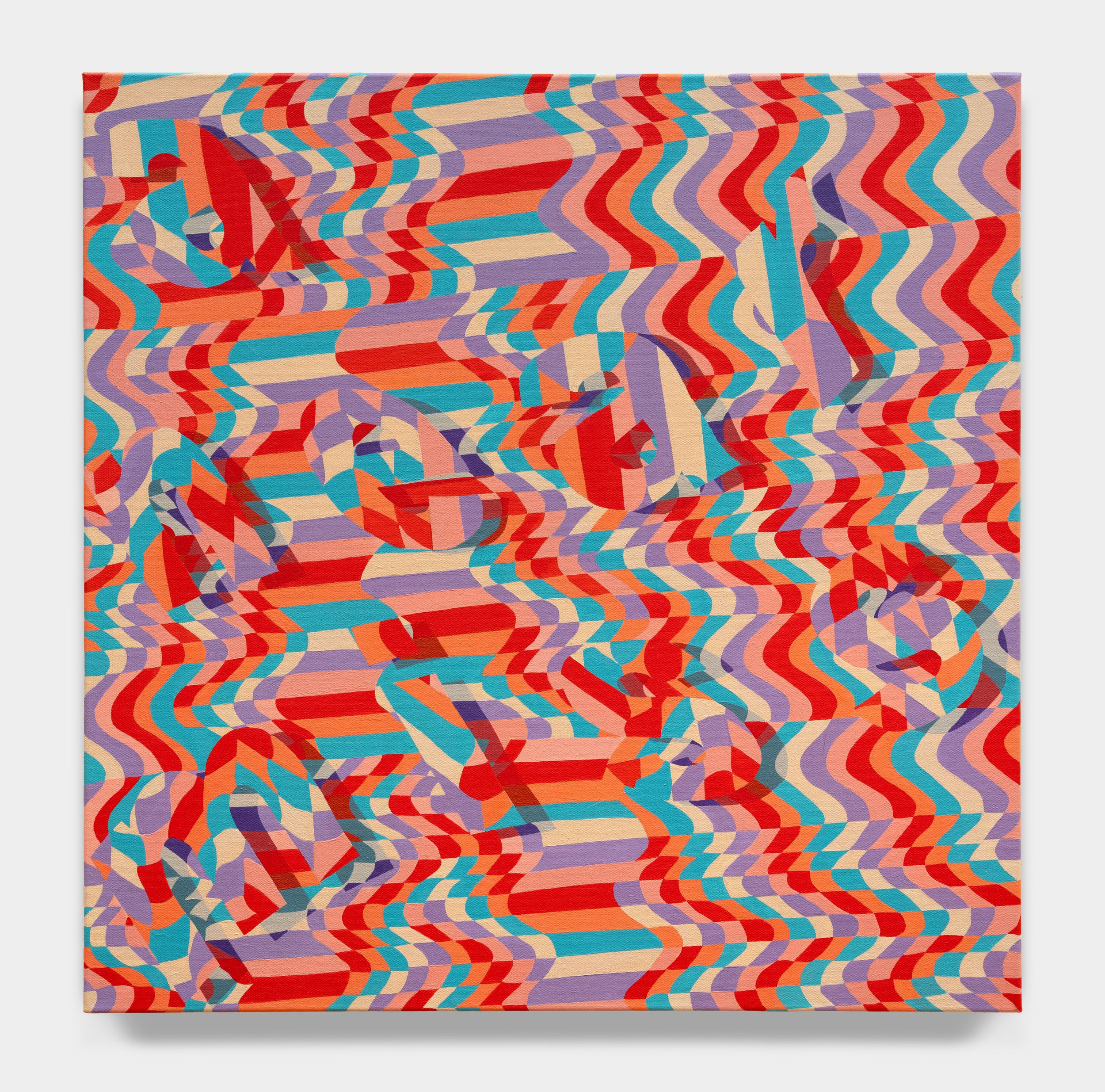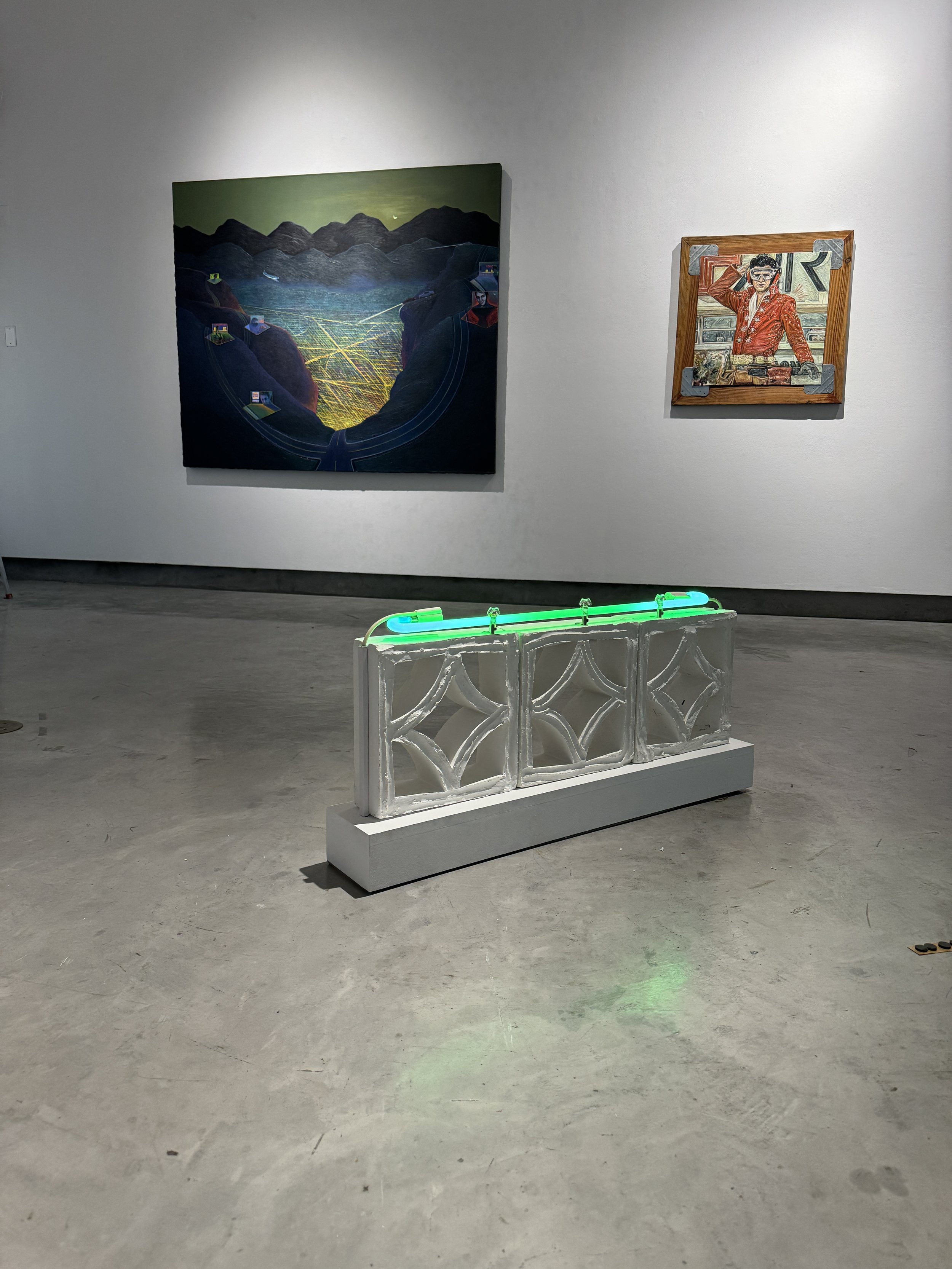Claiming Vegas
Mikayla Whitmore & Justin Favela, Circus Circus Mirror Maze (After Walter Wick), pigmented inkjet photograph, 2024. Photo courtesy Mikayla Whitmore.
Claiming Vegas
by V. Galactica
Last December, two shows wrapped up on the same weekend at Donna Beam Gallery and ASAP (Available Space Art Projects), both shaped by the neon tapestry of fantasy, spectacle, and illusion – Las Vegas. After visiting both shows, I was reminded of Joan Didion’s The White Album where she wrote “a place belongs forever to whoever claims it hardest, remembers it most obsessively, wrenches it from itself, shapes it, renders it, loves it so radically that he remakes it in his image.”
The influence of place is pervasive, no matter where you live. The local writer Amanda Fortnini writes “We derive memories, identity, meaning from the sea of stuff in which we swim.” Generally, Vegas is just like any other city. People assume an ordinary life here – raising children and struggling with cost of living much like the rest of the nation right now — but in many ways the Vegas reality is unlike any other, and this anomaly crops up in the work of many artists living here or who have lived here.
eri king was raised in Las Vegas, but has been based in New York for ten years. In her December show, scripted spaces at ASAP, I saw Las Vegas as an indelible influence on her work. Though when I chatted with her at the exhibition’s closing reception, she told me that the body of work is less about Las Vegas and more about how pattern and design influence the psyche.
The ornate patterns speculate on the subliminal in the mundane with veiled images and texts inspired by casino carpets. An inconspicuous but denotative feature as king depicts them, carpets play a part in the strategically designed psychological landscape of casino environments. The theory is that the busy, vibrant, psychedelic carpet designs are meant to stimulate - keeping bodies active - and what’s more, skewing perception. By throwing off the player’s judgement, the house gains an edge.
king's paintings dream up surreal, dizzying landscapes that emanate a lost dystopian scene. Roman columns get lost against the felt green background and the unmistakable curlicues of casino carpets. (Think of the hallucinogenic carpet scene in Fear and Loathing when Johnny Depp envisions vines from the floral casino carpet crawling up a cowboy’s legs.) King emphasized distortion by playing with the visual senses. Winding patterns were placed over stairs, something you won’t see in casino floors because it throws off one’s perception of depth.
eri king, labyrinth effect (ilinx), oil on canvas, 2024. Photo by Daniel Greer. Courtesy of the artist. © eri king
Silhouettes of cupids and discreet messages are slyly thwarted beneath the bigger picture, hiding them in plain sight. This was truly a show you had to witness in person. It wasn’t until the third or fourth painting that I began to notice deeply embedded messages and details. I swept the room, slowly, as if I were trying to find a treasure in a puzzle. I repeated this ritual three or four times. a near miss. heaven or las vegas. Text appeared as if by magic in two abstract paintings with mesmerizing and vibrant patterning. It was rewarding, in the end, to find all of the hidden elements in king’s paintings (or at least to think that I did, like a game, the gambler’s adrenaline rush.)
eri king, a near miss, acrylic on canvas, 2024. Photo by Daniel Greer. Courtesy of the artist. © eri king
Over at Donna Beam Gallery, the show Viva Las Vegas celebrated the 60th anniversary of the movie of the same name, starring Elvis Presley. The cultural history of Las Vegas was celebrated in tandem, with works from twenty-three artists and their own interpretations of the city. The UNLV campus gallery’s exhibition text also reminded viewers that a little part of Vegas history was filmed there, in what is now the Marjorie Barrick Museum of Art.
Not surprisingly, Elvis was a recurring theme and so were neon lights. A green neon tube sitting atop a breeze block, a mid-century modern architecture design that permeates old Vegas, illuminates Krystal Ramirez’s piece Neon Study. The work incorporates two very disparate concepts of Vegas - The Strip and Las Vegas’ quotidian life. In Virtually Las Vegas, a 1995 documentary I watched recently, the opening narrator states that what separates this gambling mecca from any other gambling center is the desert surrounding it that creates a kind of reality barrier, separating it from the rest of civilization. While working on The Strip, tourists would always ask where I was from. When they learned I was raised in Las Vegas, they would become baffled and shocked with disbelief, as if nothing existed beyond The Strip. But in recent years, as the city's population has grown, so has people's concept of Las Vegas as more than just a gaming town.
Krystal Ramirez, Neon Study, gypsum cement and neon, 2024. Photo courtesy Krystal Ramirez.
Mary Warner similarly brings together both the everyday and the spectacle of Vegas in Vegas World, a painting of a neighborhood, possibly Beverly Green, with Vegas World in the backdrop. Warner, mines Vegas history and evokes a sense of nostalgia, a reminder of the impermanence of the city; Vegas World is a casino that once stood in the same lot where The Strat now stands. Structures come and go on The Strip, but, in contrast, surrounding neighborhoods have been designated as historic. As a Las Vegas native, I appreciated the sense of familiarity that was palpable in Warner and Ramirez's work.
Mary Warner, Vegas World, oil on canvas, 2008. Collection City of Las Vegas. Image courtesy Donna Beam Gallery.
Artist and photojournalist Mikayla Whitmore and large-scale installation artist Justin Favela — known for his vibrant traditional Mexican papier-maché or cartonería sculptures — collaborated for Circus Circus Mirror Maze (After Walter Wick). The image of the mirror diorama creates an intricate optical illusion, and captures the excessive essence of the city in a playful way. The mirrors multiply each object and create a maze of pink (the iconic color of Circus Circus) concentric hexagons overlaid by miniature toys, mostly animals and emblems of the region. Six free-standing doorways look like portals into different dimensions. Each reflected doorway reveals a different vantage point, and unseen characters beyond the threshold become visible. This is a very intricately staged scene. If inspected closely, one can get lost in the illusion.
In these exhibitions, I witnessed contemplations of place drawn out from nostalgia, illusion, memory, history, and spectacle. Some of the works in the shows were shaped by Vegas’ tropes, but as a local, I was compelled by the more subtle references. What does it mean to remake a place in one’s image? For me, Las Vegas belongs to those who can live deep beneath the surface.
eri king, scripted spaces
Available Space Art Projects, Las Vegas
November 15 - December 13, 2024
Viva Las Vegas!
Donna Beam Gallery
November 1 - December 13, 2024
V. Galactica is a writer from Las Vegas currently pursuing an MFA from School of the Art Institute of Chicago. She can be found on IG @via.galactica
Posted by V. Galactica and published by Wendy Kveck on May 6, 2025.





